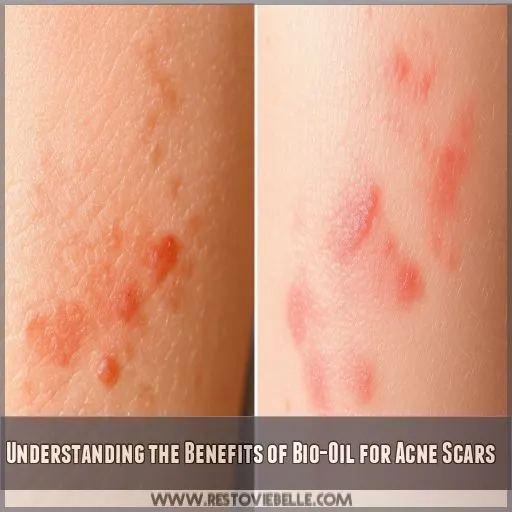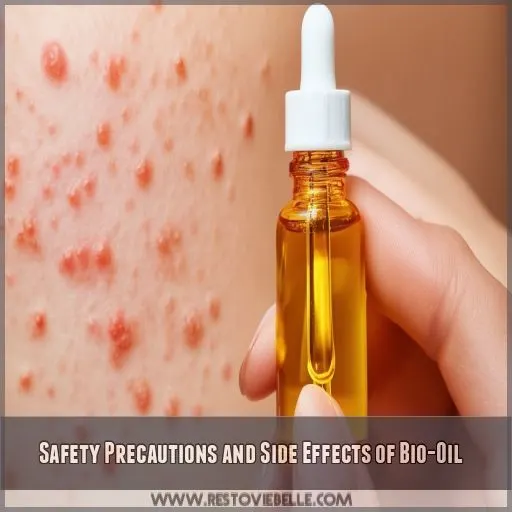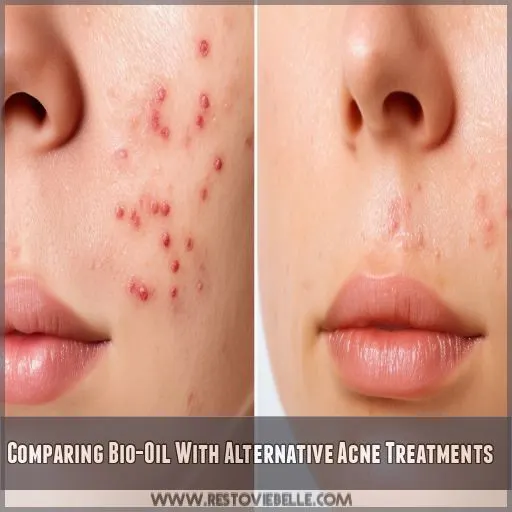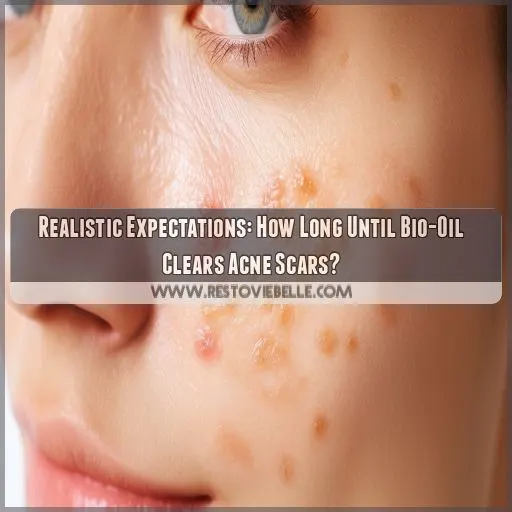This site is supported by our readers. We may earn a commission, at no cost to you, if you purchase through links.

Let’s take you through expert advice on how to effectively use bio-oil. You will learn how to apply it, realistic expectations, and its benefits. We look at how it works on different skin types and its comparison to other treatments.
Educate yourself to empower your skin in the journey of healing.
Table Of Contents
- Key Takeaways
- How to Use Bio Oil for Acne Scars?
- What is Bio-Oil and How Does It Work?
- Understanding the Benefits of Bio-Oil for Acne Scars
- How to Apply Bio-Oil for Acne Scars?
- Can Bio-Oil Help With Acne and Wrinkles?
- Using Bio-Oil for Overnight Treatment of Acne Scars
- Safety Precautions and Side Effects of Bio-Oil
- Comparing Bio-Oil With Alternative Acne Treatments
- Realistic Expectations: How Long Until Bio-Oil Clears Acne Scars?
- Consulting a Dermatologist for Acne Scar Treatment
- Frequently Asked Questions (FAQs)
- Can Bio-Oil remove acne scars?
- Do I apply Bio-Oil before or after moisturizer?
- How long does it take for Bio-Oil to clear scars?
- How to use Bio-Oil for scars overnight?
- Can Bio-Oil be used on active acne?
- Is Bio-Oil suitable for all skin types?
- How often should I replace my Bio-Oil bottle?
- Can Bio-Oil be mixed with other skincare products?
- Does Bio-Oil work on deep, pitted acne scars?
- Conclusion
Key Takeaways
- Bio-Oil isn’t just snake oil – it’s got some serious science backing it up! With ingredients like vitamins A and E, this little wonder can help fade those pesky acne scars over time. Just remember, Rome wasn’t built in a day, and neither is perfect skin.
- Consistency is key, folks! Apply Bio-Oil twice daily, and stick to it like your grandma sticks to her secret cookie recipe. A little goes a long way, so don’t go overboard – you’re not deep-frying your face, after all.
- Patch test before you go all in, unless you want to look like a tomato with commitment issues. And for the love of clear skin, keep this stuff away from active acne – it’s like inviting a bull to a china shop.
- While Bio-Oil can work wonders, it’s not a magic eraser for deep scars. If your acne scars are playing hard to get, it might be time to call in the big guns – aka a dermatologist. They’ve got tricks up their sleeves that’ll make Bio-Oil look like child’s play.
How to Use Bio Oil for Acne Scars?
Applying Bio-Oil to acne scars involves smearing it on your face after cleaning and doing this twice a day. Massage a few drops very gently into the affected areas for about 30 seconds. The thing about it is that you have to be consistent; at least use it for 8-12 weeks to see huge effects.
Compared to other products, Bio-Oil contains a unique blend of ingredients including improvement-enhancing vitamins A and E in scar appearance and skin healing promotion. While generally innocuous, always patch test first for sensitivity.
Please be advised that Bio-Oil does not work on open or fresh acne lesions, so wait until your skin has healed. Combine with a well-rounded skincare routine and healthy lifestyle habits for best results.
Ready to dive a bit deeper into maximizing the benefits of Bio-Oil?
What is Bio-Oil and How Does It Work?
Bio-Oil is a specialized skincare product that’s gained popularity for its potential to improve the appearance of scars, including those from acne. This unique formula combines a blend of plant extracts and vitamins in a base of mineral oil. At its core, Bio-Oil works by deeply moisturizing the skin, promoting elasticity, and supporting the skin’s natural healing process.
The secret sauce? It’s packed with ingredients like vitamins A and E, which are known for their skin-regenerating properties. Vitamin A aids in cell turnover, while vitamin E acts as a powerful antioxidant. The formula also includes calendula oil, lavender oil, and rosemary oil, which contribute to its soothing and healing effects.
What sets Bio-Oil apart is its PurCellin Oil technology. This ingredient reduces the thickness of the formula, making it lightweight and easily absorbed. While it’s not a miracle cure, many users report positive results when used consistently for acne scars.
Understanding the Benefits of Bio-Oil for Acne Scars
Bio-Oil offers significant benefits for acne scar treatment, with clinical trials showing improvement in scar appearance for 92% of subjects after 8 weeks of use. The product’s effectiveness stems from its key active ingredients, including vitamin A and E, which work together to promote skin cell turnover and hydration, potentially reducing the visibility of acne scars over time.
Scar Appearance Improvement
Bio-Oil’s scar-improving prowess isn’t just hype. Clinical studies show impressive results for acne scars:
- 84% of participants saw noticeable improvement
- Scars appeared lighter and less visible
- Continuous progress over 8 weeks
You’ll find Bio-Oil’s ingredient efficacy shines, with no age restrictions or pregnancy safety concerns. Treatment duration varies, but results often appear within weeks.
Key Active Ingredients
Bio-Oil is effective against acne scars because of its ingredients. It contains vitamin A, which aids in the regeneration of cells; vitamin E helps in moisturizing and healing; calendula oil promotes the growth of skin cells, whereas PurCellin oil makes the product easy to absorb.
Unlike other products that contain ingredients like salicylic acid or tea tree oil, which target only the scars, Bio-Oil’s formulation addresses multiple aspects of skin healing and regeneration.
Clinical Trial Results
You’ll be pleased to know that Bio-Oil’s efficacy isn’t just anecdotal. Clinical trials have shown promising results for acne scars and stretch marks. In one study, 84% of participants saw improvement in scar appearance. After just 15 days, 66% noticed a difference. These findings underscore Bio-Oil’s potential in skin care.
How to Apply Bio-Oil for Acne Scars?
To effectively use Bio-Oil for acne scars, you’ll need to apply it correctly and consistently. Let’s explore the key aspects of application, including how often to use it, how to prepare your skin, and what areas to avoid during treatment.
Frequency and Timing of Application
For best results on acne scars, apply Bio-Oil twice a day. These may be at any time, such as mornings and nights, but the bottom line is consistency. Massage a few drops gently onto the area affected for about 30 seconds. Don’t go overboard; sometimes, more isn’t better. Stick to this, and you’ll get optimal results.
Preparing the Skin for Application
Before applying Bio-Oil, prepare your skin to best absorb the product:
- Cleanse your face thoroughly with a gentle cleanser
- Pat dry with a clean towel
- Perform a skin patch test to check for sensitivity
Apply Bio-Oil morning and evening for optimal results. Keep in mind that it’s not a spot treatment to dry out active pimples but rather to heal acne scarring.
Avoiding Broken Skin
Do not use Bio-Oil on broken skin or open acne lesions. You’ll definitely need to patch test, mainly if you’re prone to allergic reactions or fragrance sensitivity. Allow scars to heal before treating them, and with regards to skin breakout, look out for alternatives like AHAs or see a dermatologist to perform a controlled cosmetic procedure of peeling.
Can Bio-Oil Help With Acne and Wrinkles?
Now that you know how to apply Bio-Oil for acne scars, let’s explore its potential benefits for acne and wrinkles. While primarily known for scar treatment, Bio-Oil might be your secret weapon against these common skin concerns. Here’s what you should know:
- Acne severity: Bio-Oil’s non-comedogenic formula may help manage mild to moderate acne without clogging pores.
- Wrinkles: The vitamin A content promotes cell turnover, potentially reducing fine lines and wrinkles.
- Hyperpigmentation: Bio-Oil’s blend of plant extracts might help fade dark spots and even out skin tone.
- Oily skin: Surprisingly, this oil-based product could balance your skin’s natural oil production.
Using Bio-Oil for Overnight Treatment of Acne Scars
Want to supercharge your Bio-Oil treatment for acne scars? Try using it overnight. This technique allows the product to work its magic while you catch some Z’s.
Before hitting the hay, cleanse your face thoroughly and pat it dry. Then, apply a thin layer of Bio-Oil to your acne scars using gentle, circular motions. Don’t go overboard – a little goes a long way. Let the oil absorb for a few minutes before snuggling into your pillow.
If you’re worried about staining your sheets, pop on a soft, breathable headband to keep the oil in place. This overnight treatment can be particularly effective because your skin’s natural repair processes kick into high gear while you sleep. Plus, there’s no need to worry about the oil making your face shiny during the day.
Wake up, rinse off, and hello, refreshed skin! Consistency is key, so stick with it for best results.
Safety Precautions and Side Effects of Bio-Oil
You should do a patch test before applying Bio-Oil to your acne scars to ensure there’s no sensitivity or allergic reaction to the product. Also, avoid contact with cracked or bleeding skin because of potential irritation and complications that may arise.
Patch Test and Sensitivity
While Bio-Oil might work wonders overnight, it’s incredibly critical to test its safety on your skin. Do a patch test before indulging:
- Apply a small amount behind your ear
- Observe for up to 24 hours for any reaction
- Check for redness, itching, or swelling.
- All clear, proceed with caution
Keep fragrance and essential oils at bay with very sensitive skin. For combo skin or uneven tones, Bio-Oil may just tip the scale for you into smoother sailing. Those with allergies would do better with gentler alternatives like green tea or chemical skin peeling.
Avoiding Use on Cracked or Bleeding Skin
While Bio-Oil can work wonders for acne scars, you’ll want to steer clear of using it on cracked or bleeding skin. This isn’t just about comfort—it’s about safety. Your skin’s protective barrier is compromised when it’s damaged, potentially allowing ingredients to penetrate too deeply.
If you’re dealing with severely dry or broken skin, it’s time to hit pause on Bio-Oil. Instead, focus on healing those areas first.
Consider alternative treatments or consult a dermatologist for personalized advice on restoring your skin’s health.
Comparing Bio-Oil With Alternative Acne Treatments
Comparing Bio-Oil against other acne scar treatment methods needs a little pros vs. cons weighing. On its very unique ingredients, Bio-Oil does work, especially on newer scars. However, with respect to most deep ice pick, rolling, and boxcar scars, you may need more aggressive treatment.
laser resurfacing and chemical peels do cure tough scars, but at a heftier price and with possible side effects. Microneedling stimulates collagen production and can work much better than Bio-Oil on older scars. Over-the-counter retinoids give similar benefits to Bio-Oil with the addition of possible irritation.
Where Bio-Oil really excels is in ease of use and moisturizing properties; it’s just probably not that effective for heavy scarring. Your best bet? Use Bio-Oil for mild scarring or as a part of the overall regimen. For more serious cases, consult with a dermatologist about professional treatments.
Realistic Expectations: How Long Until Bio-Oil Clears Acne Scars?
One has to be very realistic when using Bio-Oil for acne scars. There’s huge variation individually. Skin types and the size of the scars also vary. Some people start seeing visible changes after some weeks, while some have to use it uninterruptedly for months. Here you go:
- 2-4 weeks: First Improvement of Skin Texture and Hydration Visible
- 4-8 weeks: Fading of redness, slight fading of newer scars
- 8-12 weeks: More obvious improvement in scarring and overall skin texture.
- 3-6 months: Substantially faded scars in many users; constant application recommended.
Consulting a Dermatologist for Acne Scar Treatment
While Bio-Oil may work for many, the most effective means of getting rid of those acne scars is through a dermatologist. A professional will assess the severity of your scarring and advise accordingly based on considerations of skin type and skin concerns. Of course, during consultation, you’ll look at treatment options beyond over-the-counter products, possibly including laser therapy, chemical peels, or microdermabrasion—treatments that really pack a powerhouse punch against deeper scars.
Worry less about insurance coverage; most dermatologists have cheap consultation rates, and some treatments might cover many plans. Keep in mind that the best care now is going to save you time and money in the long run.
A dermatologist might also help one set out realistic expectations and provide, under a guided regime, skincare customized to your lifestyle, budget, and skin sensitivity. So why play guessing games with your skin? Take control and schedule that appointment!
Frequently Asked Questions (FAQs)
Can Bio-Oil remove acne scars?
Bio-Oil can improve the appearance of acne scars, but it won’t completely remove them. Studies show it’s most effective on newer scars, with 84% of users seeing improvement. You’ll need consistent, twice-daily application for best results.
Do I apply Bio-Oil before or after moisturizer?
Like a gentle wave caressing the shore, apply Bio-Oil after your moisturizer. This layering technique allows the moisturizer to hydrate deeply, while Bio-Oil forms a protective barrier, sealing in nutrients and targeting those stubborn acne scars effectively.
How long does it take for Bio-Oil to clear scars?
You’ll typically see improvements in scar appearance after 8-12 weeks of consistent Bio-Oil use. However, results vary based on scar age and severity. For newer scars, you might notice changes sooner, potentially within 2-4 weeks.
How to use Bio-Oil for scars overnight?
Rub it in like liquid magic. For overnight scar treatment, wash your face, apply a thin layer of Bio-Oil, massage gently, and remember not to overdo it since little goes a long way. Sweet dreams are ahead for this scar fighter!
Can Bio-Oil be used on active acne?
It’s not recommended to use Bio-Oil on active acne. The oil can clog pores and worsen breakouts. Instead, focus on treating your active acne first with appropriate products. Once it’s cleared, you can use Bio-Oil on any remaining scars.
Is Bio-Oil suitable for all skin types?
Like a gentle balm for diverse landscapes, Bio-Oil’s versatile formula adapts to various skin types. You’ll find it’s generally suitable for most, but if you’ve got sensitive or acne-prone skin, it’s wise to patch test first.
How often should I replace my Bio-Oil bottle?
You should replace your Bio-Oil bottle every 12 months after opening. Look for a small symbol on the packaging indicating its shelf life. If you notice changes in color, smell, or consistency, it’s time for a new bottle.
Can Bio-Oil be mixed with other skincare products?
You can mix Bio-Oil with other skincare products, but it’s best to apply it separately. Layer it after water-based products and before heavier creams. Always patch test new combinations to avoid potential irritation.
Does Bio-Oil work on deep, pitted acne scars?
Bio-Oil’s effectiveness on deep, pitted acne scars is limited. While it may improve skin texture and tone, it can’t fill in deep indentations. For severe scarring, you’ll likely need professional treatments like laser resurfacing or dermal fillers.
Conclusion
Ironically, the path to clear skin might lead you to apply oil. Learning how to use bio oil for acne scars can be a game-changer in your skincare routine.
While it’s not a miracle cure, bio oil offers potential benefits for improving scar appearance.
Remember to apply it correctly, be patient, and maintain realistic expectations.
If you’re unsure about using bio oil or aren’t seeing desired results, don’t hesitate to consult a dermatologist.
Your journey to smoother skin starts with informed decisions and consistent care.















